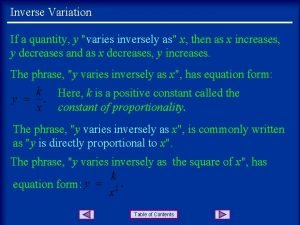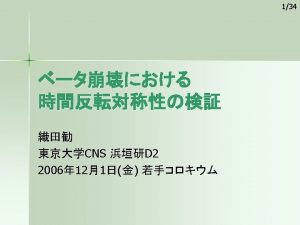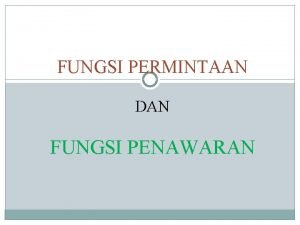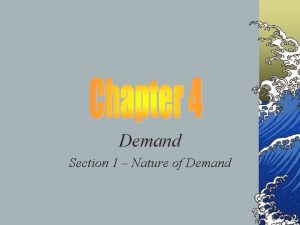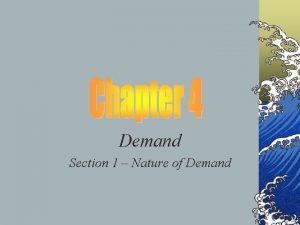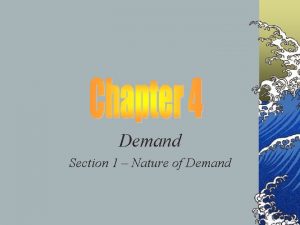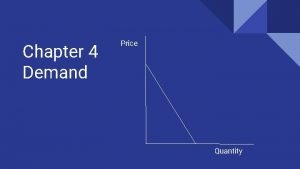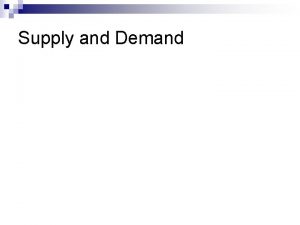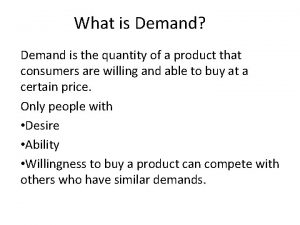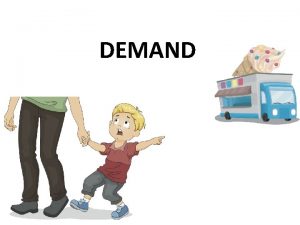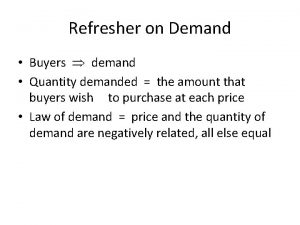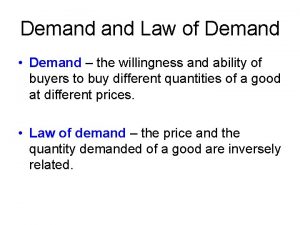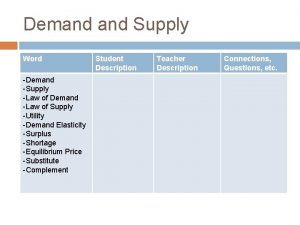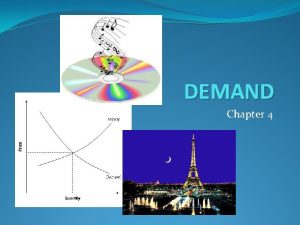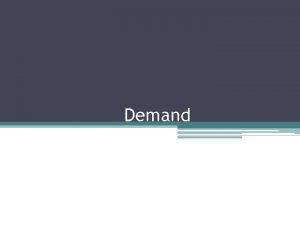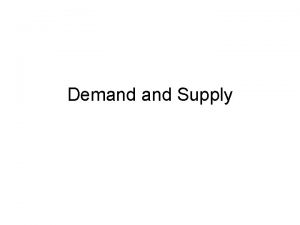The Law of Demand What is Demand Quantity































- Slides: 31

The Law of Demand

What is Demand? § Quantity demanded of a product or service is the number that would be bought by the public at a given price

The Law of Demand § When a good’s price is lower, consumers will buy more of it § When a good’s price is higher, consumers will buy less of it

The Law of Demand § The Law of Demand is affected by two behavior patterns § The Substitution Effect § The Income Effect

The Substitution Effect § As the price for one good rises compared to a similar good, consumers will substitute the similar good for their purchases.

The Income Effect § As prices go up, your money becomes worth less than it was worth before § People are less likely to buy the good now

Demand Schedule § A demand schedule shows the likely number of purchases based on a series of arbitrarily chosen prices

Demand Schedule

Demand Schedule › Demand Curve

A Change (Shift) in Demand § If one of 5 other factors changes, the entire demand curve will shift to the left or right § The curve does NOT shift if the price of the good is the only change

A Change in Demand (Graph)

A Change in Quantity Demanded (Graph)

Income § When people’s income changes, demand shifts accordingly § Normal Goods – § Higher income = higher demand § Lower income = lower demand

Income § When people’s income changes, demand shifts accordingly § Inferior Goods – § Higher income = lower demand § Lower income = higher demand

Consumer Expectations § If consumers expect a price to rise in the future, current demand increases § If consumers expect a price to fall in the future, current demand decreases

Population § When one sector of the population grows, demand increases for products that sector uses § Fastest growing sector of the population today?

Consumer Tastes and Advertising § Increased advertising can increase consumer demand § Bad news about a product can decrease demand

Price of Related Goods § Complimentary Goods – goods that are bought and used together § Higher Complementary Price = decrease in demand § Lower Complementary Price = increase in demand

Price of Related Goods § Substitute Goods – goods that are used in place of one another § Higher Substitute Price = increase in demand § Lower Substitute Price = decrease in demand

Elasticity of Demand § Elasticity refers to how responsive the quantity demanded is to a change in prices

Elasticity of Demand § An inelastic good will still sell about the same quantity even if the price goes up or down

Elasticity of Demand § An elastic good will have a higher change in Qd when there is a price change

Calculating Elasticity § Elasticity = % change in quantity demanded _____________ % change in price

Calculating Elasticity § If Elasticity is < 1, the good is inelastic § If Elasticity is > 1, the good is elastic § If Elasticity = 1, the good has a unitary elastic demand

Factors Affecting Elasticity § Availability of Substitutes – if you have no other options, demand is inelastic.

Factors Affecting Elasticity § Availability of Substitutes – if you have equally appealing options, demand is highly elastic

Factors Affecting Elasticity § Relative Importance – what percentage of your budget is spent on the good? § If it is low, price changes will not alter demand § If it is high, even small price changes can greatly affect demand

Factors Affecting Elasticity § Necessities vs. Luxuries – consumption of milk might stay the same with price changes, while consumption of lobster would greatly change with price changes

Factors Affecting Elasticity § Change over time – price changes may produce inelastic demand in the short term, but elastic demand long term § 1970 s fuel crisis – people still bought the same amount of gas at first, but eventually started buying smaller cars

Elasticity and Revenue § Total Revenue – the amount of money a company receives by selling its good or service § With elastic demand, revenue will decrease greatly with price increases

Elasticity and Revenue § With Inelastic demand, price increases will increase revenue
 Scalar quantity and vector quantity
Scalar quantity and vector quantity Vector and scalar quantities
Vector and scalar quantities A vector quantity has
A vector quantity has A quantity t varies inversely with a quantity
A quantity t varies inversely with a quantity Scalar vector tensor
Scalar vector tensor Fungsi demand
Fungsi demand Newton's first law and second law and third law
Newton's first law and second law and third law Newton's first law
Newton's first law Boyle's law charles law avogadro's law
Boyle's law charles law avogadro's law Avogadro's law constant
Avogadro's law constant Hình ảnh bộ gõ cơ thể búng tay
Hình ảnh bộ gõ cơ thể búng tay Ng-html
Ng-html Bổ thể
Bổ thể Tỉ lệ cơ thể trẻ em
Tỉ lệ cơ thể trẻ em Gấu đi như thế nào
Gấu đi như thế nào Chụp phim tư thế worms-breton
Chụp phim tư thế worms-breton Hát lên người ơi alleluia
Hát lên người ơi alleluia Kể tên các môn thể thao
Kể tên các môn thể thao Thế nào là hệ số cao nhất
Thế nào là hệ số cao nhất Các châu lục và đại dương trên thế giới
Các châu lục và đại dương trên thế giới Công thức tính thế năng
Công thức tính thế năng Trời xanh đây là của chúng ta thể thơ
Trời xanh đây là của chúng ta thể thơ Mật thư tọa độ 5x5
Mật thư tọa độ 5x5 Làm thế nào để 102-1=99
Làm thế nào để 102-1=99 độ dài liên kết
độ dài liên kết Các châu lục và đại dương trên thế giới
Các châu lục và đại dương trên thế giới Thể thơ truyền thống
Thể thơ truyền thống Quá trình desamine hóa có thể tạo ra
Quá trình desamine hóa có thể tạo ra Một số thể thơ truyền thống
Một số thể thơ truyền thống Cái miệng bé xinh thế chỉ nói điều hay thôi
Cái miệng bé xinh thế chỉ nói điều hay thôi Vẽ hình chiếu vuông góc của vật thể sau
Vẽ hình chiếu vuông góc của vật thể sau Biện pháp chống mỏi cơ
Biện pháp chống mỏi cơ



